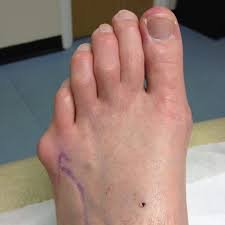Bunions can be a painful and persistent problem that affects millions of people worldwide. Often caused by a combination of genetic factors, ill-fitting footwear, and repetitive stress on the foot, bunions can significantly impact your quality of life. If left untreated, they can lead to chronic discomfort, difficulty walking, and even joint deformities. This is where Bunionplasty comes into the picture.
In this article, we will explore what bunionplasty is, its benefits, and how it can help you find relief from bunion pain while restoring your foot’s natural function.
What is a Bunion?
Before delving into bunionplasty, let’s first understand what a bunion is. A bunion, medically known as hallux valgus, is a bony bump that forms at the base of the big toe. It develops when the bones in the front part of your foot become misaligned, causing the big toe to lean towards the second toe. This misalignment creates a protrusion on the side of the foot, which can become swollen, painful, and inflamed over time.
Common symptoms of bunions include:
- Redness and swelling around the affected joint
- Persistent pain, especially when wearing tight shoes
- Restricted movement of the big toe
- Calluses or corns due to overlapping toes
Understanding Bunionplasty: A Modern Approach to Bunion Surgery
Bunionplasty is a minimally invasive surgical procedure specifically designed to correct bunion deformities. Unlike traditional bunion surgeries that often require extensive incisions and longer recovery times, bunionplasty focuses on achieving both functional and cosmetic outcomes.
This procedure involves realigning the bones in the foot to correct the misalignment causing the bunion. Surgeons often use advanced imaging techniques and specialized tools to make precise corrections, ensuring minimal disruption to surrounding tissues.
Key Features of Bunionplasty:
- Cosmetic Focus: The procedure leaves smaller scars compared to traditional surgeries, making it an appealing choice for individuals concerned about the aesthetic appearance of their feet.
- Minimally Invasive: Smaller incisions lead to reduced pain, swelling, and faster recovery.
- Advanced Techniques: Surgeons employ state-of-the-art tools to improve precision and optimize results.
How Does Bunionplasty Work?
The bunionplasty procedure typically involves the following steps:
1. Pre-Surgical Evaluation
Before the surgery, your surgeon will conduct a thorough assessment of your foot. This includes physical exams, X-rays, and discussions about your symptoms, lifestyle, and goals. The evaluation helps determine the severity of the bunion and whether bunionplasty is the right option for you.
2. Anesthesia and Preparation
On the day of the surgery, local or general anesthesia will be administered to ensure your comfort. The surgeon will then prepare the area by sterilizing it to minimize the risk of infection.
3. Realignment of Bones
Using specialized surgical tools, the surgeon will make a small incision near the affected joint. The bones causing the bunion are carefully repositioned to their natural alignment. In some cases, tiny screws or plates are used to secure the bones in place.
4. Soft Tissue Adjustment
If necessary, surrounding tendons or ligaments may be adjusted to support the corrected alignment. This ensures the joint functions properly post-surgery.
5. Closing the Incision
The incision is closed using dissolvable sutures or adhesive strips. The small size of the incision minimizes scarring and promotes faster healing.
Benefits of Bunionplasty
Bunionplasty offers numerous advantages, making it a preferred option for many patients dealing with bunions. Here’s how it can help:
1. Pain Relief
By correcting the structural deformity causing the bunion, bunionplasty alleviates pressure on the affected joint, significantly reducing pain and discomfort.
2. Improved Mobility
The procedure restores the natural alignment of your foot, enabling you to walk, run, and engage in daily activities without limitations.
3. Enhanced Aesthetics
For those concerned about the appearance of their feet, bunionplasty provides a more cosmetically pleasing outcome with minimal scarring.
4. Faster Recovery
Thanks to its minimally invasive nature, bunionplasty often results in shorter recovery times compared to traditional bunion surgeries. Many patients are able to resume light activities within a few weeks.
5. Long-Lasting Results
With proper post-operative care, the results of bunionplasty are typically permanent, allowing patients to enjoy improved foot health for years to come.
Who is a Good Candidate for Bunionplasty?
Bunionplasty is suitable for individuals experiencing moderate to severe bunion symptoms that have not responded to conservative treatments such as orthotics, physical therapy, or anti-inflammatory medications. You may be a good candidate if:
- You experience persistent pain that affects your daily life
- The bunion has caused noticeable changes in foot structure
- Non-surgical treatments have not provided adequate relief
- You have realistic expectations about the procedure and recovery
Post-Operative Care and Recovery
Proper post-operative care is essential to ensure a smooth recovery and optimal results. After bunionplasty, your surgeon will provide detailed instructions, which may include:
- Wearing a protective boot or splint to support the foot
- Avoiding weight-bearing activities for a few weeks
- Elevating the foot to reduce swelling
- Performing gentle exercises to maintain mobility
- Attending follow-up appointments for progress monitoring
Most patients are able to return to regular activities within six to eight weeks, though full recovery may take a few months.
Why Choose Bunionplasty Over Traditional Surgery?
While both bunionplasty and traditional bunion surgery aim to correct foot deformities, the former offers distinct advantages in terms of aesthetics, recovery, and patient satisfaction. Here are some reasons why bunionplasty is gaining popularity:
- Less Invasive: Smaller incisions mean less pain and quicker healing.
- Customizable Outcomes: Surgeons can tailor the procedure to meet both functional and cosmetic goals.
- Reduced Risk of Complications: Advanced techniques minimize the risk of infection, scarring, and joint stiffness.
Conclusion
Living with a bunion can be painful and frustrating, but modern medical advancements like bunionplasty offer a promising solution. This minimally invasive procedure not only alleviates pain but also restores the natural function and appearance of your foot. Whether you’re looking to regain mobility, improve aesthetics, or enjoy a pain-free lifestyle, bunionplasty is an effective and reliable treatment option.



